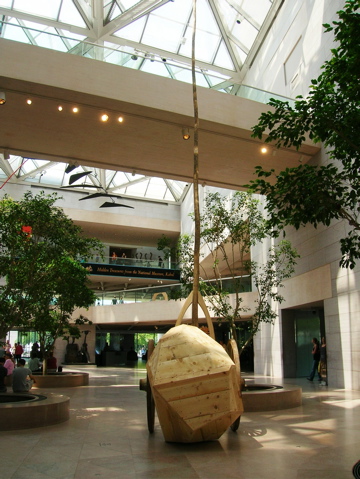
There is no substitute for seeing Martin Puryear’s sculptures firsthand. Martin Puryear at the National Gallery of Art in Washington D.C., spanning the museum’s two buildings, offers such an opportunity through September 28, 2008. In Art:21’s Martin Puryear episode (Season 2) I first learned about his working methods and interest in materials, both important elements in the 50 plus sculptures on view.
The contrast of the stone of the East Building with the wood of Puryear’s sculptures on view in the East Building is breathtaking. The East Building’s spacious court also gives Puryear’s sculptures room to breathe (a sense of life Puryear has talked about his sculptures having).
In the West Building’s Rotunda, Ladder for Booker T. Washington (featured prominently in Art:21) is installed. From certain angles the sculpture is dwarfed by the rotunda’s scale and the sculpture’s placement may even go unnoticed by some visitors. The time-lapse photographs of the installation and seeing the work installed offer possibilities for thinking about and discussing how installation and the choice of site affects the perception of (and potentially the interpretation) of a work of art.
Puryear’s sculptures are also shown in multiple galleries in the West Building. A gallery with five circular sculptures from 1978 to 1980 caught my attention. All wood (though different varieties), some are painted while the natural is manipulated in others. The ends of some connect, while others overlap and a few stop short of the ends meeting. While all circular, Puryear here offers the many possibilities of the circle. Each sculpture reflects the considerations he made his choices.
If you are not able to see Puryear’s sculptures firsthand, or if you want to share them with your students, the National Gallery has some useful online resources including images (with details of the surfaces) and a Family Guide with interesting, thoughtful questions to consider while looking at Puryear’s work.
This exhibition left me thinking about choices: Puryear’s choices of materials, choice in terms of the ways he works with materials, choices in repeating forms, choice of titles, as well as the choice of site. The choices artists make is one of my favorite themes to talk about with students visiting a museum. While formal analysis is often used to discuss choices, as an educator how have you discussed with your students the choices an artist has made in a work of art?




Pingback: Nasher Museum Blogs » Blog Archive » Julie Thomson for Art 21